When fruit trees are whitened, what composition is best to use for whitewashing?
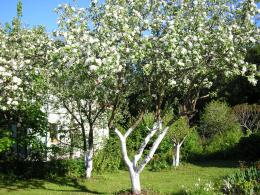
Tree trunks coated with white composition give garden Overall a special and festive look. But it is clear to everyone that gardeners periodically renew the whiteness of their trunks not at all in order to give them a special design. First of all, the treatment of trunks in spring and autumn is carried out solely in order to protect them from the harmful effects of ultraviolet rays.
Content:
- Why are trees whitewashed?
- When are fruit trees whitened?
- Composition for whitewashing trees
- Lime whitewash
- Is it possible to whitewash trees with water-based paint?
- Useful tips for whitewashing trees
Why are trees whitewashed?
In order to still understand the question: why do they still whitewash? trees, you need to understand that bark is as important for a tree as skin is for the human body.
The presence of good, undamaged bark is very important for a tree, as it protects against:
- the harmful effects of sudden temperature changes
- influence of sharp gusts of wind and scorching sun rays
- rodents, which, with the help of their powerful teeth, can cause irreparable harm to both the bark and the entire tree as a whole
Natural factors have a very detrimental effect on unprotected bark: after a certain amount of time, the bark becomes too rough, this contributes to the appearance of multiple cracks and, as a result, peeling begins to occur.
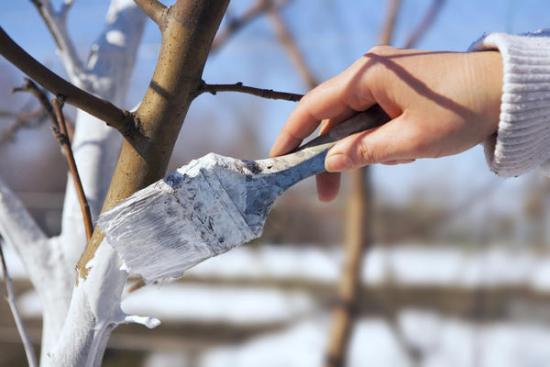
Naturally, all the processes described above significantly reduce the protective functions and, in most cases, lead to the death of everything plants.
From this we can conclude: the cortex should be perceived as a protective and protective organ, which in turn needs some protection.
This kind of protection can be provided by whitewashing, which will become a reliable barrier for:
- possible burns from ultraviolet rays both in winter and spring (it is during these time periods that the sun can be quite aggressive and due to the partial or complete absence foliage have a negative impact directly on the trunk)
- the appearance of cracks associated with a sharp interseasonal change in temperature (during this period, per day, the temperature can change by 10 degrees or more)
- harm caused insects, feeding on bark and living in it
- the harmful effects of possible severe and prolonged frosts in winter
The whitewashing process should be treated as responsibly as possible. Experts strongly recommend whitewashing both decorative trees and fruit and berry trees.
When are fruit trees whitened?
Gardeners with extensive experience whitewash trees at least 3 times throughout the year: at the beginning spring, summer and autumn. The main and most important whitewashing is autumn. It is better to do it at the onset of the first frost, that is, approximately in mid-October.
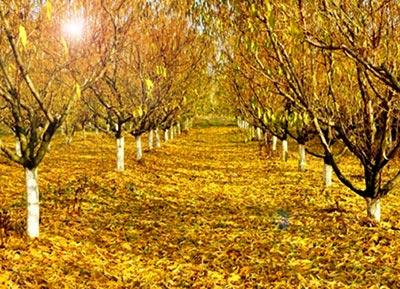
Whitewashing done in the fall will protect trees from:
- from the formation of ice on the bark
- from pests that have settled in the bark and infections of fungal origin
- to some extent - from voracious hares (it has been verified that they do not like lime-covered bark)
In cases where, for some reason, whitewashing the garden in the autumn was not successful, it can be done in February. This time period is especially dangerous for the plant: the bark, heated during the day to +10 C, causes the onset of sap flow, and night temperatures, which can be below -10 C, cause deep freezing of the trunk.
Thus, the sap turns into crystals, which severely injure or tear wood tissue. The result is the appearance of very deep cracks in the plant bark.
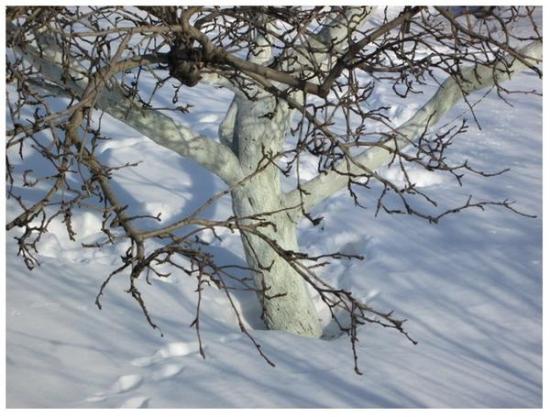
The surface treated with whitewash reflects the sun's rays and warms up much more slowly. Consequently, awakening from hibernation begins only when a real warm spring comes and the possibility of night frost practically absent.
The autumn whitewashing carried out during the period does not exclude repeated processing in the last ten days of March.
Summer whitewashing is generally carried out only in cases where, during the time that has passed since the previous one, natural factors, that is, rains, have washed away the previously applied composition. If the treatment was carried out with a leave-in composition, summer treatment, in principle, can be omitted. To carry out garden processing work, it is advisable to choose a quiet and warm day.
Composition for whitewashing trees
As a material for whitewashing, you can use either a solution of chalk or lime, or water-dispersion or water-based garden paint.
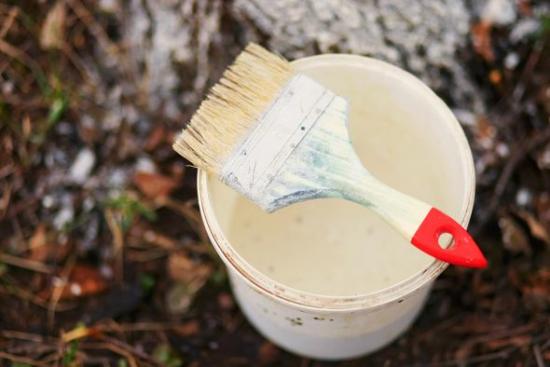
If desired, you can prepare the solution yourself using one of the following recipes.
Whitewashing trees with lime
To prepare a lime mortar, you will need the following ingredients: wood glue, slaked lime, clay, copper sulfate as a disinfectant.
The advantages of this recipe include its fairly simple preparation from available materials and minimal financial costs for their purchase.
The disadvantages include: quick rinsing at the slightest contact with moisture and providing very unreliable protection for the bark. But this type of protection is very common among summer residents and has its fans.
It is prepared according to the following recipe in quantitative equivalents: lime (if it is not available, it can be replaced with chalk), in the amount of 3 kg per 10 liters of liquid, glue (casein glue is a suitable substitute) about 100 g, copper sulfate 0.5 kg. All ingredients are mixed in one container, the specified amount of water is added, mixed well and left to infuse for several hours.
Lime with manure
It is prepared according to the following recipe: put in a large container: 1 kg of fresh manure, 1 kg of lime, 0.200 g of copper sulfate. Then pour all the components with 10 liters of water, mix until a homogeneous mass is formed and leave for several hours.
If you slightly increase and change the quantitative ratio of the components and add casein glue, you can get a solution that will stay on the bark a little longer and thereby form a better protection for the bark. To obtain it, you will need to mix 2 kg of lime, 100 g of glue and 400 g of copper sulfate in a container. You will also need water, then good mixing and time for infusion.
White fatty clay can be used as a substitute for glue. For 10 liters of liquid you will need approximately 1 kg.
Is it possible to whitewash trees with water-based paint?
For those who are wondering whether it is possible to paint trees with water-based paint, the answer is as follows: experts unanimously say that it is possible. This type of painting is more practical compared to lime paint.
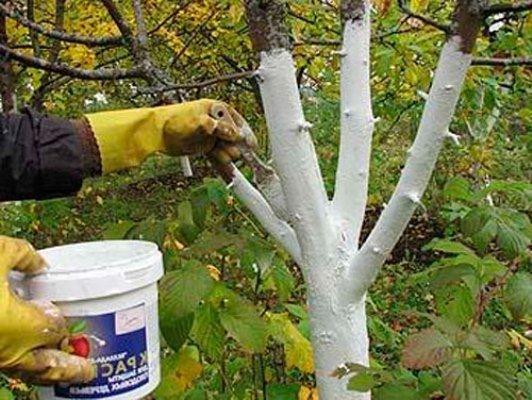
The option with a water-based composition is considered the most optimal, since it fully provides protection from the harmful rays of the sun and creates a layer that is very resistant to a humid environment.
The advantages of using paint as protection include:
- White fatty clay can be used as a substitute for glue. For 10 liters of liquid you will need approximately 1 kg.
- For those who are wondering whether it is possible to paint trees with water-based paint, experts unanimously say that it is possible. This type of painting is more practical compared to lime paint.
The option with a water-based composition is considered the most optimal, as it fully provides protection from the harmful effects solar rays and creates a layer that is very resistant to humid environments.
The advantages of using paint as protection include:
- a fairly long period of retention on the surface of the cortex (about 2 years);
- ability to pass oxygen;
- ability to protect against ultraviolet rays.
Painting with water-based emulsion is carried out at a temperature not lower than +3 C. Application of two layers is considered mandatory. Moreover, the second layer should be applied only after the first has completely dried.
You can make the paint for whitewashing garden trees yourself. To do this, you will need bustilate or any other adhesive composition with a latex base.
The ingredients are mixed in the following percentage ratio: to one part of the pigment, it does not matter whether it is chalk or clay, add 2 parts of latex glue. The components are mixed until completely dissolved.
After this, you can begin to add water to the resulting mass, but not in large parts. Water must be added until the composition reaches a consistency reminiscent of oil paint.
To apply paint to the surface you will need tools. These can be either paint rollers or brushes: flat brushes, paint brushes, flat brushes, and so on. There isn't much difference. The most important thing is that the application of the composition is convenient for the gardener.
If the garden is large enough and the trees to be painted are mature with thick stems, then for maximum convenience you can use a spray gun.
One more thing, sometimes on forums gardeners You may be faced with the question of whether it is possible to whitewash trees with acrylic paint. Experts do not object to the use of such material.
The acrylic coating lasts a long time, does not harm the tree, and provides adequate protection to the trunk.
As for the synthetic origin of paint, everyone has a choice - to use chalk or lime, or more reliable modern materials.
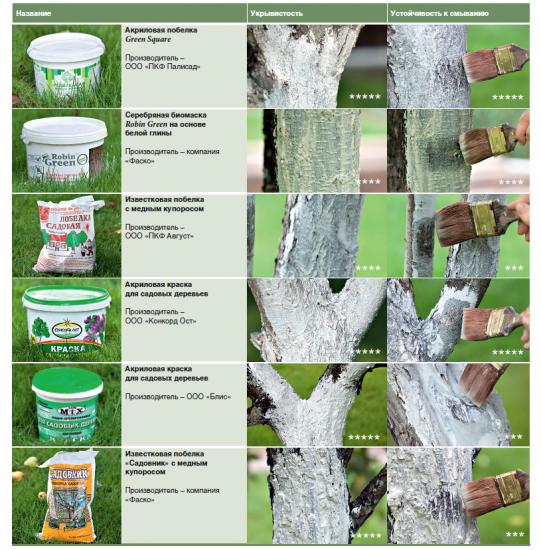
Useful tips for whitewashing trees
After the question of how to whiten trees to prevent them from being washed off has been clarified, experienced gardening specialists recommend:
- The protective layer must be applied to the tree to a sufficient height, which is about 2 meters.
- The coating should be not only on the trunk part, but also on a third of the length of the lower skeletal branches.
- Before applying whitewash, the wood should be prepared for this process.On a damp day, moss and excess twigs, loose pieces and lichens need to be removed from the bark. The use of tools in this process that could cause any harm or damage to the trunk is strictly prohibited.
- The work must be done with hands protected by gloves made of dense material.
- The various recesses are cleaned with a small wooden knife or a sharpened peg.
- Fragments of bark affected by any diseases are removed and burned without fail.
On a day when the weather forecast does not predict precipitation, disinfection is carried out with the following composition:
- Bordeaux mixture
- copper sulfate solution 3%
- the drug Oxychom or HOM.
The solution is applied to the wood using a sprayer. Spraying should be done from a finely dispersed spray, so that the composition from it dissipates like fog, and does not flow down the trunk.
You will learn the secrets of high-quality autumn whitewashing by watching the video:

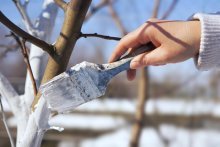

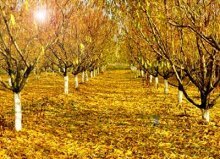
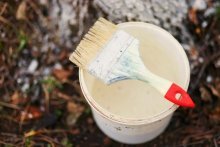
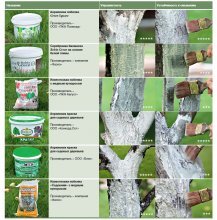
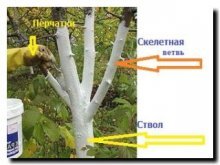
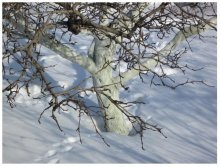
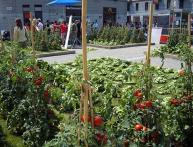
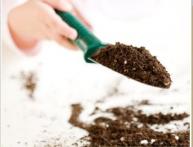


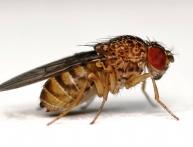
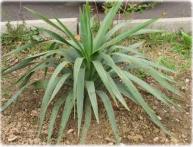
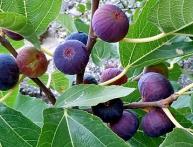
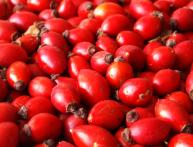
Comments
I buy a special whitewash for trees, because I didn’t know how to make it myself. This year I will definitely use the tips from the article and experiment with different means.
I use ordinary lime for these purposes, I most often treat trees in early spring, I don’t see any special contraindications regarding water-based emulsion, but cheap ceiling lime will quickly be washed away by rain, and it’s simply a pity to spend expensive façade lime for such purposes.